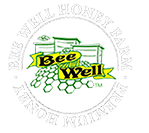
We love this time of year. The trees are green, flowers are beginning to bloom and the weather is warm. Ah, the lazy days of summer.
Summer is perfect for honey bees…. right? So, what is summer nectar dearth?
What is Summer Nectar Dearth?
Honey bee colonies store nectar and pollen to use in times of dearth. To a honey bee, a dearth is a shortage of nectar-producing flowers. The most obvious nectar dearth occurs during the winter, but many places also experience a summer nectar dearth, a hot and dry period between spring flowers and autumn flowers.
This time of shortage may escape a new beekeeper’s notice because, after all, it is summer and the world is green. Sometimes flowers are clearly visible and it’s easy to assume that if flowers are present, the bees are happy. But not all flowers produce nectar accessible to honey bees. And among those that do, the amount of nectar can be reduced by low rainfall, excessive heat, or other less-than-ideal growing conditions.
The summer nectar dearth can be devastating to a honey bee colony. At times, it can destroy a colony faster than a cold winter. Whereas a bee colony has time to prepare for winter by increasing storage and decreasing population, a summer dearth hits when populations are very high. Large numbers of bees—especially active bees—require a lot of food. A large colony can wipe out its warehouse very quickly, and if the beekeeper has already harvested, the problem is worse.
Desperate times call for desperate measures, and a severe summer nectar dearth can cause many types of unwanted behavior. Simply put, idle bees get into trouble.
What Should a Beekeeper Do?
Once you recognize a dearth, you may want to take actions to minimize the damage a dearth can cause. Listed below are some considerations for colony management.
- Feeding syrup during a summer dearth is a two-edged sword. On the one hand, if your colony is low on stores, feeding may keep them from starving. On the other hand, the presence of feed can quickly alert robbers to a feast. If you decide to feed, resist using an entrance feeder because the odor will bring robbers right to the front door. Instead, use an internal or enclosed hive-top feeder and avoid drips and spills.
- If you have a strong nectar flow in autumn, feeding bees during the summer dearth has advantages. Normally, the hive population drops during a dearth because when nectar stops coming in, the queen restricts her egg laying. A good supply of syrup keeps the colony population higher, and a bigger colony going into autumn will be better able to harvest the late nectar flows.
- If you decide to feed colonies during a dearth, do not use essential oils or Honey-B-Healthy. At this time of year, these products can entice bees from miles around. Don’t worry, your bees will have no trouble finding the syrup in their hive.
- Reduce entrances. Robbing is always a possibility even if you are not feeding. Reduce your entrances and, for small or weak colonies, consider using a robbing screen.
- Close upper entrances. It is harder for your bees to defend two or more entrances. If you are using upper entrances, close them off during the dearth. If you need upper ventilation use a screened inner cover or an eke (two- or three-inch super) with screened ventilation ports.
- Do not put community feeders or wet frames near your apiary. Either one can start a frenzy that invites robbers to your area. If you want your wet frames cleaned by your bees, put the frames in a super inside the hive.
- If possible, schedule hive manipulations for late in the day. Bees go home at night, so opening hives late in the day allows time for the odors to dissipate before morning. It also gives nighttime scavengers an opportunity to clean up any drips and spills.



